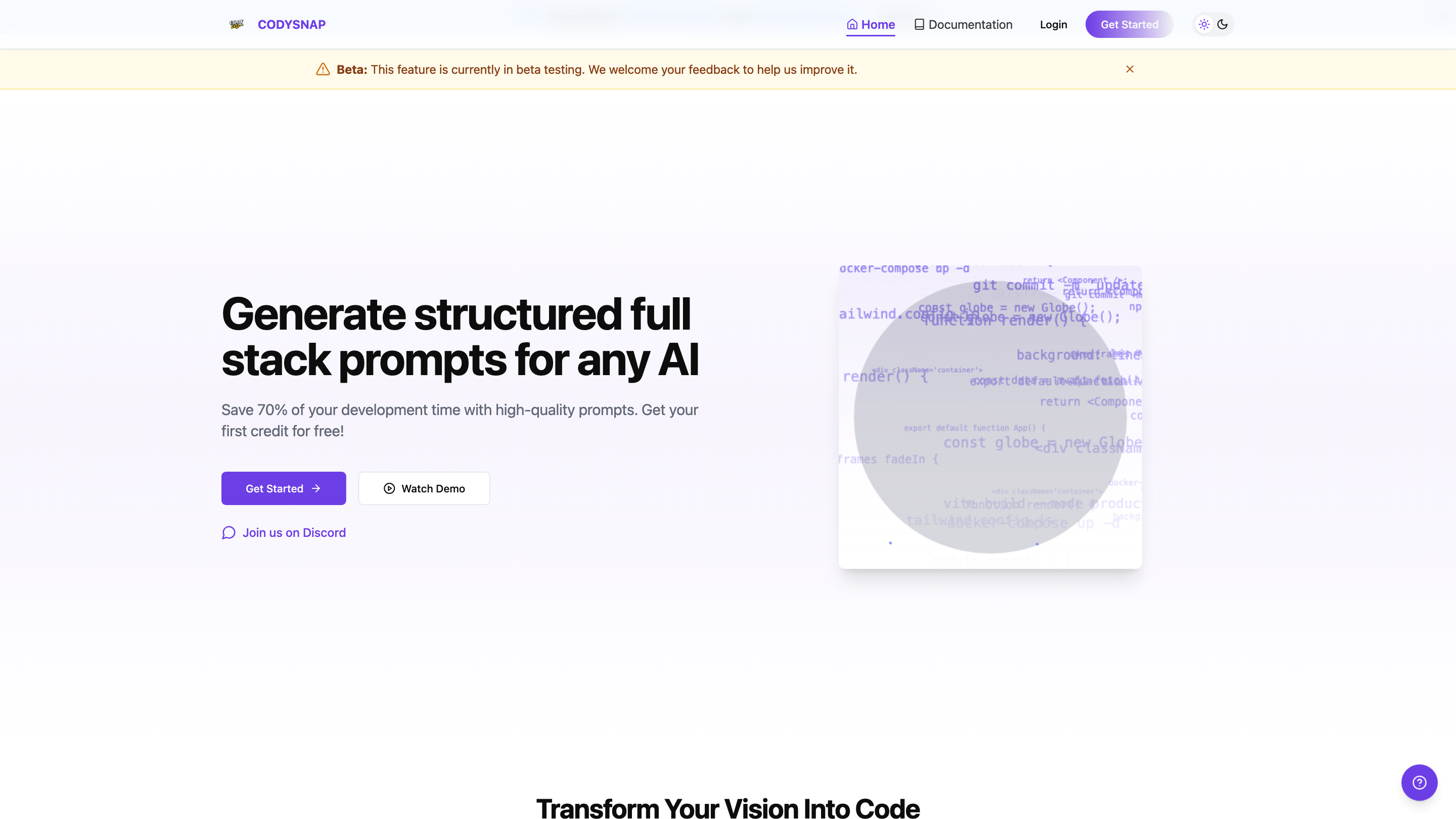CODYSNAP
Open siteCoding & Development
Introduction
Transform screenshots into web application prompts.
CODYSNAP Product Information
CODYSNAP — Generate structured prompts for full‑stack development
CODYSNAP is an AI-assisted platform that creates comprehensive, structured prompts to guide the end-to-end development of full‑stack applications. It breaks complex projects into guided phases, providing implementation prompts for UI, frontend, backend, database, APIs, authentication, and deployment. The tool emphasizes time savings, consistency, and developer-friendly prompts that align with modern tech stacks (React, TypeScript, TailwindCSS, REST/GraphQL, and database integrations).
How CODYSNAP works
- Define your project and requirements (project scope, target users, tech stack).
- Follow a guided Development Journey with clearly defined phases and milestones.
- Generate structured prompts for each phase (UI/UX, frontend components, backend services, database schema, API contracts, tests, and deployment).
- Implement instructions in your preferred AI tool or code editor to build the application end-to-end.
Development Journey overview
- Structured Development Process: From analysis to deployment with guided phases.
- Smart Dependencies: Automatic management of phase prerequisites.
- Integrated Implementation: Works with your existing codebase and infrastructure.
- Idea to Implementation: Convert design concepts into executable prompts.
- Upload Designs: Share screenshots or mockups to inform prompts.
- Requirements & Prompts: Precisely specify frontend/backend needs and generate prompts accordingly.
- Customization: Tailor prompts to features, styling, and required integrations.
Core features
- Guided, multi-phase development journey (idea to implementation)
- Phase-by-phase prompts for UI, frontend, backend, database, APIs, and deployment
- Smart task dependencies across development phases
- Customizable prompts aligned with React, TypeScript, Tailwind CSS, and modern tooling
- Works with popular AI tools and your favorite editor/IDE
- Ideal for rapid prototyping, standardization, and team collaboration
- Includes example project templates and architecture blueprints
Example project blueprint and architecture
Example Task Component interface (TypeScript)
interface TaskProps {
id: string;
title: string;
status: 'todo' | 'in-progress' | 'done';
priority: 'low' | 'medium' | 'high';
assignee?: User;
dueDate?: Date;
}
const Task = ({
title,
status,
priority,
assignee,
dueDate
}: TaskProps) => {
// Implementation details...
}
Component Architecture (example)
- React with TypeScript and Tailwind CSS
- Reusable component library with Storybook documentation
- Responsive design with light/dark theming
Example of a Generated Prompt (high level)
- Define a complete Task Management module: data models, UI components (TaskCard, TaskList, KanbanColumn), state management, API contracts, and tests.
- Produce a single source of truth for component props, data shapes, and interactions.
- Provide code scaffolds, file structure, and integration points for REST/GraphQL APIs, authentication, and real‑time updates.
Component Architecture and Project Structure (illustrative)
- Frontend: React + TypeScript + Tailwind CSS
- State management: React Query + Zustand/Context
- Backend: REST or GraphQL with authentication (OAuth2 or JWT)
- Database: PostgreSQL or Supabase-compatible schema
- Tests: Unit and integration tests (Jest + React Testing Library)
- Deployment: CI/CD pipelines (GitHub Actions or similar)
Color palette, typography, and design guidance
- Primary colors, typography system, and spacing guidelines can be generated or customized per project
- Style tokens and design system components can be produced in prompts for consistent UI across features
Implementation steps (typical flow)
- Setup project scaffold with chosen stack (e.g., Vite + TypeScript + React + Tailwind)
- Define authentication and user models
- Create core UI component library and theming
- Model data with type-safe interfaces and API contracts
- Build features per phase (task management, analytics, collaboration, notifications, etc.)
- Implement tests and accessibility checks
- Configure deployment pipelines and environment variables
- Iterate with feedback and additional feature prompts
How to use CODYSNAP
- Start with a project brief or mockups
- Generate a Development Journey tailored to your stack
- Use the produced prompts to drive your AI coding assistant or to implement directly in your editor
- Refine prompts as your requirements evolve
Additional resources
- Example prompts for UI components, data models, API layers, and deployment configurations
- Patterns for scalable React architectures and clean code organization
Implementation Guide (sample prompts you’ll receive)
- Project Definition: capture goals, audience, success metrics, and constraints
- UI/UX Design: responsive layouts, navigation, and accessibility considerations
- Frontend Development: component library, state flows, routing, and data fetching
- Backend Integration: API endpoints, authentication flows, and data validation
- Database & Storage: schemas, relations, indexing, and migrations
- Testing & QA: test plans, coverage targets, and test data
- Deployment: environment setup, CI/CD, and monitoring
Example Deliverables
- Comprehensive project blueprint with architecture diagrams
- Detailed component trees and prop interfaces
- API surface definitions (REST/GraphQL)
- Database schemas with relations and constraints
- End-to-end implementation prompts compatible with popular AI coding tools
